Yale
-
- MLC Mandated Medical Management for Mariners Maritime Logistics Professional, Q1 2014 #55
Managed medical care specialist Future Care is changing the way the maritime industry looks at mariner healthcare.
The Maritime Labour Convention 2006 (MLC) has forever changed the way vessel operators look at healthcare for the world’s 1.3 million mariners. For some, it means simple compliance with a minimum set of standards and managing the costs associated with that standard. For others, MLC is a call to arms for those who work to make sure that healthcare at sea means more than just emergency telemedicine services.
For Christina DeSimone, CEO of Future Care, Inc., managed healthcare means competent telemedicine for seafarers who suffer injuries or become ill hundreds of miles out to sea. It can also means following up on every case that they are call on to handle; managing cost, assignment of the right physician and ensuring that a seafarer gets the right treatment at the right facility. That attention continues through physical rehabilitation and the ultimate goal of returning the mariner to work as quickly as is possible. More than that, however, Future Care’s managed healthcare solution means establishing a baseline history for every seafarer on the planet – before they ever step onto a vessel.Studying Seafarer Health: a fulltime job
In May of last year, an ambitious effort to bring seafarer healthcare to a new, higher standard kicked off when the Yale University School of Medicine, in conjunction with managed healthcare solution provider Future Care, Inc., released a study entitled Preliminary Evaluation of Seafarers Health Care and Determination of Predictors of Illness. For perhaps the very first time, the effort to provide proactive as opposed to reactive healthcare to mariners was underway. Until now, very little research had been conducted on the health and general welfare of the world’s 1.3 million seafarers who collectively spend their time traveling, living and working on vessels far away from their home countries.
Future Care’s CEO, Christina DeSimone, determined that there was an immediate need for an analysis of the incidence of illness and injury among this singular group, with particular emphasis on their special risk factors. The ultimate goal is to draw conclusions that will assist in the development of improved programs for the prevention of illness and injury on board and the efficient treatment of seafarers’ medical issues when these do occur.
The initial study did have its limitations. These included the absence of preliminary, initial health data associated with each mariner. Dr. Rafi Lefkowitz of the Yale School of Medicine told MarPro in February, “One of the things that is limiting in the preliminary study is that we don’t have data on all the crew on the ship that have not yet been hurt or injured. So, we have statistics on the people that have experienced problems or had to call Future Care. The big lacking variable with seafarers is that people (shipowners / operators) don’t know who is on the ships to begin with. We don’t (yet) understand the population that is at risk and that’s exactly what we are trying to develop.”
According to Future Care’s DeSimone, the shipowners themselves have to participate and share data. Manning agents will be important, as well. Recently, Future Care and Yale were fortunate to obtain additional medical statistics covering 10,000 Filipino seafarers to add to the data. Once collated and analyzed, newly secured conclusions will be released to industry.
Future Care in Action
Future Care's 24/7 First Response "Caring for the Crew" program provides the shipowner with opportunities for medical cost containment, throughout the world. Future Care CEO Christina DeSimone defines a managed care specialist as a company that uses medical expertise to manage a patient or injured worker back to maximum medical recovery with the best possible care in the right time frame. Future Care’s maritime solutions mean providing the crewmember the best care in the right time frame. She adds, “We will arrange with the medical facility as to what that means and ensure that it happens by monitoring the care. We minimize the disability by maximizing the procedure. You get a worker that’s viable to return to work.”
Using the Future Care model, the point of managed care is to supervise, but not provide care that is given. A quick return to fit for duty status ultimately results in a reduction in maintenance and cure costs. That’s because there is a medical professional managing and supervising the patient’s treatment with the goal of getting the patient the best care which will reduce his time under a physicians care. This also includes making sure the patient is taking his medication, going to physical therapy. Future Care case management commences the moment the illness through the providing of maximum care. DeSimone adds, “In the case of a U.S. seaman who already has insurance, we will monitor the rehabilitation of that mariner.”
As many as 25,000 crewmembers are under the Future Care umbrella at this time, with quality operators such as Teekay (120 vessels), Genco and General Maritime among their clients. As MLC talks about enhanced healthcare solutions, other shipowners are being encouraged to provide a medical first response plan. DeSimone wouldn’t estimate how much the new rules could impact the business, except to say that it would probably increase as more owners look for ways to ramp up care for crewmembers and demonstrate compliance with the law.
Telemedicine Redefined
Telemedicine isn’t a new concept. What’s different about the Future Care approach is that it stresses prevention and primary healthcare, as well. Christina DeSimone says, “We developed the program for primary healthcare; not just emergencies. We want them to able to call even if there is a small issue that they might otherwise ignore, because those are the problems that can turn into a big issue if not attended to quickly. We think that’s what is different about our program is that it involves an active wellness program. It means that healthcare services have to be rendered at sea. Medical solutions at sea are not just about answering an SOS call.”
Future Care’s telemedical physician advisory service closes the risk gap for ship owner and the insurance company by providing a managed care service that starts within the first hour of a medical incident on board the vessel. DeSimone says, “We patch a physician advisor through to the Captain, using satellite communications to begin a process of treatment even before they reach port. We collectively have our doctors in a virtual call center, and call in the right doctor, on call at the right time for a given incident.”
Future Care Managing Director Larry Jacobson explains the approach further. “People get caught up in the various technologies and video conferencing, all of which of course enhances the quality of the diagnostic procedure. But, when you strip away all the technology, what you have left is the quality of the physician on the other end. What separates us from the competition is the quality of our network physicians. Most if not all have been remotely treating seafarers on ships for many years, hence they are more adept at asking the appropriate questions.”
And, telemedicine, says DeSimone, shouldn’t end when the call is over. “Managed care means continuity of care. There are services that provide medical advice where the captain can call up and get advice. But, once the seaman gets to shore, they’re not available anymore. The person who did the initial diagnosis isn’t going to be involved any longer. Our physicians and medical personnel will be in touch and make contact and provide supervision all the way to the medical cure. Taking care of a case – from beginning to end – is where we bring value to the crewman and to the employer.”
Preventative Medicine Starts with Data
Illnesses can’t always be caught in pre-employment physicals. It can be age-related, degenerative, or sometimes, just another surprise. DeSimone explains, “That’s why Yale is studying our statistics. We want to quantify what kind of illnesses are problems. This might involve more extensive pre-employment physicals, wellness programs on board the vessels. It’s about preventative care.”
To that end, Future Care has put out a collective message to the maritime community on how much value there will be in setting up preventative medicine programs for mariners. DeSimone says, “We need the cooperation of manning agents, because they’re the ones who hire and place the people aboard the vessels and they keep the medical records and certificates. And, we need to put the study together that includes that data – a blind study about the total population of mariners, something that would reveal so much more for us.”
Future Care hopes that the statistics will help them better manage the cases when they do happen. For example, two months after seaman “a” gets on board, he experiences an illness. With the pre-employment medical data at hand, it becomes a tool to help better diagnose the problem and solve it before it becomes a bigger issue. And, that data would be de-identified until the moment it is actually needed. Larry Jacobson explains, “We are mindful of our responsibility to protect privacy. Original data is de-identified and is never released to anyone else. But, it is almost impossible to do a good job with their healthcare without being able to link the individual to his/her data.”
The Bottom Line
Cost is a significant issue for shipowners and P&I Clubs. DeSimone addresses that issue, saying, “We have contracted rates with the hospitals – the same kind of rate that a preferred provider might have with a hospital or physician.” Without a managed solution, foreign mariners might be brought into a U.S. facility and be charged retail rate which, as it is, might be 50 percent higher. “We look to get our clients the lower rates and ensure that unnecessary procedures and charges aren’t a part of the final tally.”
As good as the Future Care service might be, and discounting all the benefits it can bring to the mariners themselves, it still has to be sold to the shipowners, who look to the bottom line in everything that they do. Martin Slade underscored that point by saying, “We look at the economics, as well. It’s clear to us that a healthier workforce is economically beneficial, but we want to be able to quantify that. If we can do that, we’ll have more people buying in. We’re starting to get data on who’s getting on board, and very soon, we hope to have defining analytics on rates, as opposed to just who is injured.” No doubt, when that happens, the bottom line will be therefore happier for everyone.
(As published in the 1Q 2014 edition of Maritime Professional - www.maritimeprofessional.com)
-
- Shipyard Productivity Reaches New Heights Marine News, Sep 2016 #48
and tools that allow them to be agile, efficient, and nimble. As a manufacturer of one such tool — the synthetic heavy lifting sling Fortis² — Yale Cordage has seen this movement through a unique vantage point – one where seemingly small details and tools are optimized for big results. Back in May
-
- MLC 2006 & You Maritime Logistics Professional, Q3 2013 #62
, and there is now a legal responsibility implied in the MLC that gives crew the right to have a medical specialist consider their illness. Future Care & Yale Earlier this year the Yale University Occupational and Environmental Medicine Program, in collaboration with Future Care, Inc., reported initial results
-
- Moving Ahead with MLC: the true course to compliance. Maritime Logistics Professional, Q3 2014 #36
of a mariner. For that reason alone, the well being of mariners is central to the central purpose of MLC. With that in mind, more than one year ago, the Yale University School of Medicine, in conjunction with managed healthcare solution provider Future Care, Inc., released a study entitled Preliminary Evaluation
-
- Hahnfeldt Appointed Power Division Sales Manager At H.O. Penn Machinery Maritime Reporter, Dec 15, 1984 #26
manager for H.O. Penn Machinery Co. Inc.'s power division by vice president Henry Killian. Mr. Hahnfeldt joined H.O. Penn in 1968 after graduating from Yale University. He has held several positions, including credit manager and finance representative. In 1976 he accepted a sales position with the constructi
-
- Donald Caldera Named Senior VP-Marketing For Midland Affiliated Maritime Reporter, Apr 1981 #7
has held other executive positions in the marine and land transportation industry in operations, administration, and finance. He is a graduate of Yale Law School, and also earned a bachelor of science degree from Webb Institute of Naval Architecture. He is a member of the American and New York
-
- Bruce W e i n s t e in A p p o i n t e d C o o r d i n a t or At B u t t e r w o r t h Systems Maritime Reporter, Mar 15, 1980 #11
, Electric Power Conversion System, where he worked in international marketing. Mr. Weinstein received a B.A. degree in American studies from Yale University, and is currently completing an MBA program at Fairleigh Dickinson University. Butterworth Systems Inc. is located at 224 Park Avenue
-
- Extreme Applications Demand Specialist Small Craft Marine News, Oct 2014 #34
to helicopter transport for remote insertion and extraction of personnel, they still need to consider how to move their craft. For example, Maine-based Yale Cordage has developed a range of heavy duty rope slings to handle boats that are carried under helicopters. Government Accounts Manager, Skip Yale explained
-
- Robert Hague Post Honors James A. Farrell Jr. Maritime Reporter, Sep 1978 #18
A. Farrell was raised and has lived in Connecticut most of his lifetime, where his grandfather settled in 1845. He received his bachelor's degree from Yale University and served as an officer in the U.S. Naval Reserve during World War II. Because of his father's strong conviction that the African trade pot
-
- Ellicott Machine Corporation Announces Personnel Changes Maritime Reporter, Dec 1985 #68
company. Prior to Ellicott Mr. Bowe worked for the Morgan Guaranty Trust Co. of New York as a loan officer in the Energy Group. He has a B.A. degree from Yale University and a MBA from Harvard. Douglas J. Piper to vice president. In his new position Mr. Piper will oversee the company's engineering, estimating
-
- James A. Farrell Jr. Receives Admiral Of The Ocean Sea (AOTOS) Award Maritime Reporter, Oct 15, 1977 #6
, management and government leaders. James A. Farrell Jr. was elected president of the newly formed American South African Line upon his graduation from Yale in 1926. In the ensuing years, he extended his company's services to all three coasts of Africa and is credited with doing the most to create an
-
- World And U.S. Bulk Shipping Maritime Reporter, Sep 15, 1978 #46
under the control of an independent chairman. Besides the directors of H.P. Drewry, the Seminar team consists of Professor Norman who was educated at Yale and Massachusetts Institute of Technology, and was assistant professor at the Institute for Shipping Research in Bergen, Norway, from 1971 to 1975
-
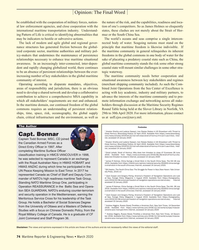 )
March 2020 - Maritime Reporter and Engineering News page: 74
)
March 2020 - Maritime Reporter and Engineering News page: 7414 January 2020. HMAS ANZAC during which time he participated in the 5 Bill Hayton, The South China Sea: The Struggle for Power in Asia (New Haven: Yale Univer- UN Peace Keeping Mission to East Timor. In 2017 he sity Press, 2014) xvi represented Canada as Chief of Staff and Deputy Com- 6 Zack Cooper
-
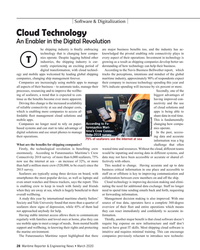 )
March 2020 - Maritime Reporter and Engineering News page: 28
)
March 2020 - Maritime Reporter and Engineering News page: 28or forwarding information. A study this year by international maritime charity Sailors’ Management decision making is also improved. With one Society and Yale University found that more than a quarter of source of true data, operators have a complete 360-degree seafarers show signs of depression, while 45%
-
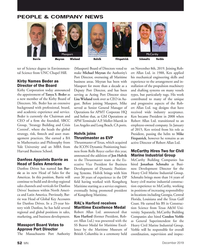 )
December 2019 - Marine News page: 52
)
December 2019 - Marine News page: 52he remains as an Thrustmaster as EVP in Mathematics and Philosophy from Thrustmaster of Texas, which acquired active Director of Robert Allan Ltd. Yale University and an MBA from the ICON Dynamic Positioning busi- Harvard Business School. ness from Rolls Royce earlier this year, McCarthy Hires Two
-
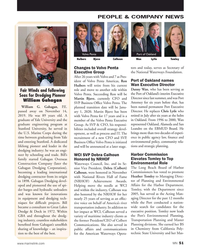 )
December 2019 - Marine News page: 51
)
December 2019 - Marine News page: 51. He replaces Chris Lytle who 2019. He was 89 years old. A with Volvo Penta for 17 years and is a retired in July after six years at the helm graduate of Yale University and the member of the Volvo Penta Executive in Oakland. From 1996 to 2000, Wan graduate engineering program at represented Oakland, Alameda
-
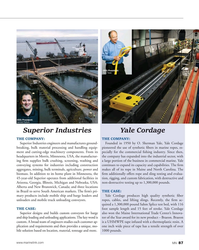 )
August 2018 - Marine News page: 87
)
August 2018 - Marine News page: 87CEO/President: Tom Yale CEO/President: Jarrod Felton Superior IndustriesYale Cordage THE COMPANY: THE COMPANY: Superior Industries engineers and manufactures ground- Founded in 1950 by O. Sherman Yale, Yale Cordage breaking, bulk material processing and handling equip- pioneered the use of synthetic ?
-
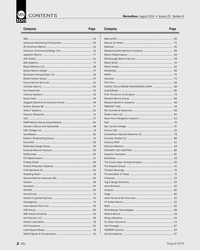 )
August 2018 - Marine News page: 2
)
August 2018 - Marine News page: 2..........................................................70 KVH Industries ............................................................................. 62 Yale Cordage ................................................................................. 87 Lake Assault Boats .................................
-
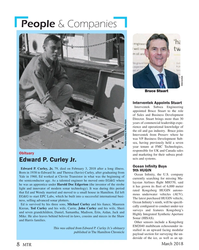 )
March 2018 - Marine Technology Reporter page: 8
)
March 2018 - Marine Technology Reporter page: 83, 2018 after a long illness. 9th HUGIN Born in 1938 to Edward Sr. and Theresa (Savio) Curley, after graduating from Ocean In? nity, the U.S. company Yale in 1960, Ed worked at Clevite Transistor in what was the beginning of currently searching for missing Ma- the semiconductor age. As a talented engineer
-
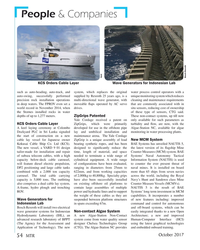 )
October 2017 - Marine Technology Reporter page: 54
)
October 2017 - Marine Technology Reporter page: 54installed rocks in water of these type of sensors, CTG said. depths of up to 1,277 meters. These non-contact systems, up till now ZipGrips Patented Yale Cordage received a patent on only available for such parameters as KCS Orders Cable Layer ZipGrips, which were primarily turbidity and ? ow, are now
-
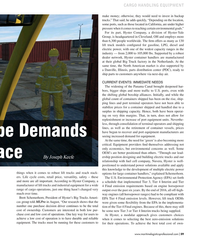 )
Jul/Aug 2017 - Maritime Logistics Professional page: 59
)
Jul/Aug 2017 - Maritime Logistics Professional page: 59located in California, are under higher pressure when it comes to reaching certain environmental goals.” For its part, Hyster Company, a division of Hyster-Yale Group, is headquartered in Cleveland, OH and employs more than 6,300 people worldwide. The frm offers as many as 130 lift truck models confgured
-
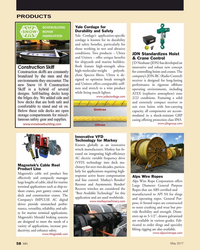 )
May 2017 - Marine News page: 58
)
May 2017 - Marine News page: 58PRODUCTS Yale Cordage for Durability and Safety Yale Cordage’s application-speci
-
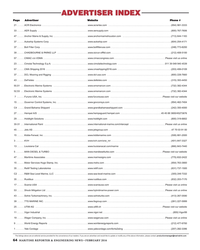 )
February 2016 - Maritime Reporter and Engineering News page: 64
)
February 2016 - Maritime Reporter and Engineering News page: 64. . . . . . . . . .www.worldenergyreports.com . . . . . . . . . . . . . . . . . . . . . . . . . . . . . . . . . . . . . . . . .(212) 477-6700 1 . . . . . . .Yale Cordage . . . . . . . . . . . . . . . . . . . . . . . . . . . . . . . . . . . . . .www.yalecordage.com/fortis2sling . . . . . . . . . . . . . . . .
-
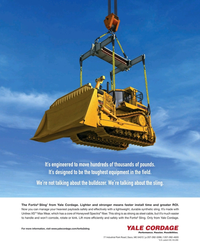 )
February 2016 - Maritime Reporter and Engineering News page: 1
)
February 2016 - Maritime Reporter and Engineering News page: 1designed to be the toughest equipment in the field. We’re not talking about the bulldozer. We’re talking about the sling. 2 * The Fortis Sling from Yale Cordage. Lighter and stronger means faster install time and greater ROI. Now you can manage your heaviest payloads safely and effectively with a lightweight
-
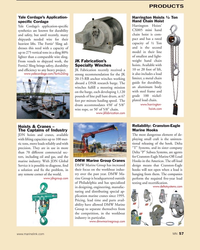 )
September 2016 - Marine News page: 57
)
September 2016 - Marine News page: 57PRODUCTS Yale Cordage’s Application- Harrington Hoists ½ Ton Hand Chain Hoist speci? c Cordage Harrington Hoists’ Yale Cordage’s application-speci? c CX005 mini hand synthetics are known for durability chain hoist is com- and safety, but until recently, many pact and has a rated shipyards needed
-
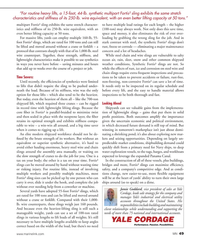 )
September 2016 - Marine News page: 49
)
September 2016 - Marine News page: 49and complete the job ships around (so to speak) on a dime. without ever needing help from a coworker or machine. Jamie Goddard, vice president of sales at Yale Several yards have adopted 55-foot Fortis² slings, which Cordage, leads sale strategy for the company and are rated for 100 tons and can be lifted
-
 )
September 2016 - Marine News page: 48
)
September 2016 - Marine News page: 48at 1/8th the Weight As a manufacturer of one such tool — the synthetic heavy Fortis² is a multi-part sling made of Unitrex XS Max- lifting sling Fortis² — Yale Cordage has seen this move- wear synthetic cable that has a core of Honeywell Spectra ment through a unique vantage point – one where seem- HMPE ?
-
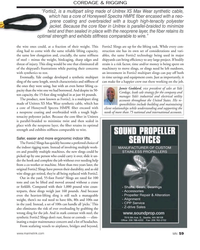 )
May 2016 - Marine News page: 59
)
May 2016 - Marine News page: 59to move slings, or slings need be left outdoors, with synthetics to rest. an investment in Fortis2 multipart slings can pay off both Eventually, Yale cordage developed a synthetic multipart in time savings and equipment costs. Just as importantly, it sling of the same length, stretch characteristics
-
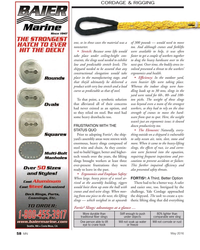 )
May 2016 - Marine News page: 58
)
May 2016 - Marine News page: 58be a better way. A safer would hoist them up onto the hull with and easier one, too. Intrigued by the cranes and steel-wire slings. When mov- challenge, Yale Cordage approached ing from one piece to the next, the lifting the shipyard. The task: to create a syn- slings — which weighed in at upwards thetic
-
 )
May 2016 - Marine News page: 57
)
May 2016 - Marine News page: 57CORDAGE & RIGGING New Synthetic Slings Allow for Lighter Lifting on the Job Yale Cordage’s Fortis2 Slings can maximize ef? ciency and minimize common jobsite hazards. By Jamie Goddard t a large American shipyard, a new kind of synthetic ic round slings for certain jobs and enjoyed the lightweight
-
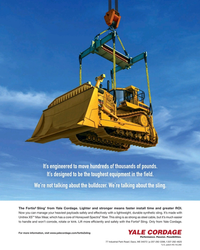 )
April 2016 - Maritime Reporter and Engineering News page: 15
)
April 2016 - Maritime Reporter and Engineering News page: 15designed to be the toughest equipment in the field. We’re not talking about the bulldozer. We’re talking about the sling. 2 * The Fortis Sling from Yale Cordage. Lighter and stronger means faster install time and greater ROI. Now you can manage your heaviest payloads safely and effectively with a lightweight
-
 )
April 2016 - Marine News page: 64
)
April 2016 - Marine News page: 64Company . . . . . . . . . . . . . . . . . . . . . . . .www.munsonboats.com . . . . . . . . . . . . . . . . . . . . . . . . . . . .(360) 707-2752 13 . . . . .Yale Cordage . . . . . . . . . . . . . . . . . . . . . . . . . . . . . . . . . .www.yalecordage.com . . . . . . . . . . . . . . . . . . . . . . . . . .
-
 )
March 2016 - Maritime Reporter and Engineering News page: 11
)
March 2016 - Maritime Reporter and Engineering News page: 11designed to be the toughest equipment in the field. We’re not talking about the bulldozer. We’re talking about the sling. 2 * The Fortis Sling from Yale Cordage. Lighter and stronger means faster install time and greater ROI. Now you can manage your heaviest payloads safely and effectively with a lightweight
-
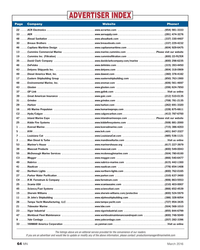 )
March 2016 - Marine News page: 64
)
March 2016 - Marine News page: 64Fleet Maintenance . . . . . . . . . . . . . . . . . . . . . .www.workboatmaintenanceandrepair.com . . . . . . . . . . . . . .(800) 748-5049 9 . . . . . .Yale Cordage . . . . . . . . . . . . . . . . . . . . . . . . . . . . . . . . . .www.yalecordage.com . . . . . . . . . . . . . . . . . . . . . . . . . .
-
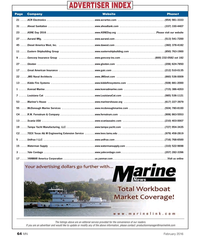 )
February 2016 - Marine News page: 64
)
February 2016 - Marine News page: 64. . . . . . . . . . . . . . . . . . . . . . . . . . . .www.watermansupply.com . . . . . . . . . . . . . . . . . . . . . . . . . .(310) 522-9698 3 . . . . . .Yale Cordage . . . . . . . . . . . . . . . . . . . . . . . . . . . . . . . . . .www.yalecordage.com . . . . . . . . . . . . . . . . . . . . . . . . . .
-
 )
November 2015 - Maritime Reporter and Engineering News page: 151
)
November 2015 - Maritime Reporter and Engineering News page: 151University magna cum laude and velopment and sales for Rybovich. He Long-time Teekay leader David Glendin- tober at the Mariners’ Memorial Chapel from Yale Law School. maintains both USCG 1600 and MCA ning, president of Teekay Gas Services, on the campus of the United States Mer- 3000 GRT licenses, and
